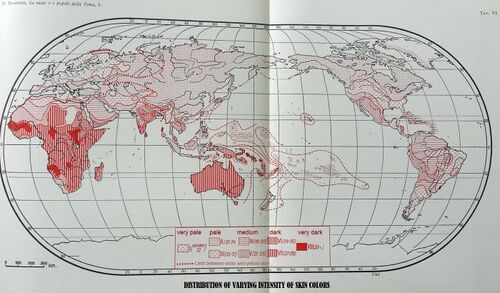Medicine:Von Luschan's chromatic scale

Von Luschan's chromatic scale (VLS) is a method of classifying skin color. It is also called the von Luschan scale or von Luschan's scale. It is named after its inventor, Felix von Luschan. The equipment consisted of 36 opaque glass tiles which were compared to the subject's skin, ideally in a place which would not be exposed to the sun (such as under the arm). The von Luschan scale was used to establish racial classifications of populations according to skin color; in this respect it is in contrast to the Fitzpatrick scale intended for the classification of the skin type of individuals introduced in 1975 by Harvard dermatologist Thomas B. Fitzpatrick to describe sun tanning behavior.[2]
The von Luschan scale was used extensively throughout the first half of the 20th century in race studies and anthropometry. However, the results were inconsistent: in many instances, different investigators would give different readings of the same person. The von Luschan scale was largely abandoned by the early 1950s, replaced with methods utilizing reflectance spectrophotometry.
The following table shows the 36 categories of the von Luschan scale in relation to the six categories of the Fitzpatrick scale:[3][4]
| Fitzpatrick type | von Luschan scale | Also called |
|---|---|---|
| I | 0–6 | Very light or white, "Celtic" type[5] |
| II | 7–13 | Light or light-skinned European[5] |
| III | 14–20 | Light intermediate, or dark-skinned European[5] |
| IV | 21–27 | Dark intermediate or "olive skin"[5] |
| V | 28–34 | Dark or "brown" type |
| VI | 35–36 | Very dark or "black" type |
References
- ↑ Jablonski. The Evolution of Human Skin Color. p. 600. http://sites.psu.edu/ninajablonski/wp-content/uploads/sites/10224/2014/02/Jablonski.2004.ARA_.585ff.pdf.
- ↑ Fitzpatrick TB: Soleil et peau [Sun and skin]. Journal de Médecine Esthétique 1975; 2:33-34
- ↑ Human Evolutionary Biology. Cambridge University Press. 2010. p. 177. ISBN 978-0521879484. https://books.google.com/books?id=1VXX1jkhPH8C. Retrieved 24 May 2016.
- ↑ "Fitzpatrick Skin Type". Australian Radiation Protection and Nuclear Safety Agency. http://www.arpansa.gov.au/pubs/RadiationProtection/FitzpatrickSkinType.pdf.
- ↑ Jump up to: 5.0 5.1 5.2 5.3 these are commonly encountered names for the types, e.g. US Army "Healthy Skin Campaign" goldnbrown.co.uk , hautzone.ch
Further reading
- von Luschan F (1897). Beiträge zur Völkerkunde der Deutschen Schutzgebieten. Berlin: Deutsche Buchgemeinschaft.
- von Luschan F (1927). Völker, Rassen, Sprachen : Anthropologische Betrachtungen. Berlin: Deutsche Buchgemeinschaft.
External links
- Von Luschan's Chromatic Scale (in Italian) (at bottom) and other anthropometric instruments at the Natural History Museum of Florence
 |


